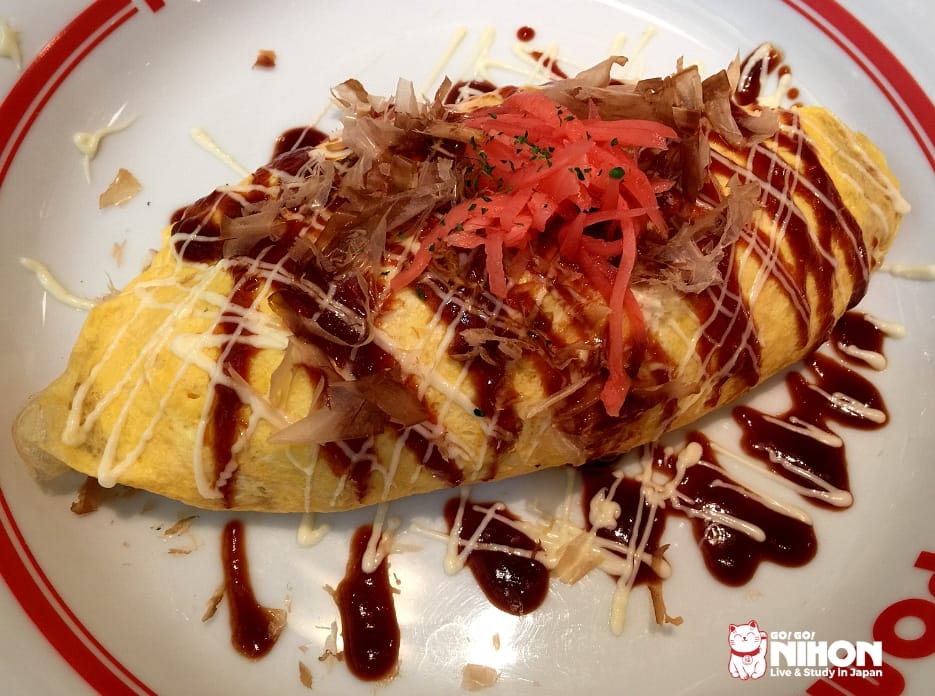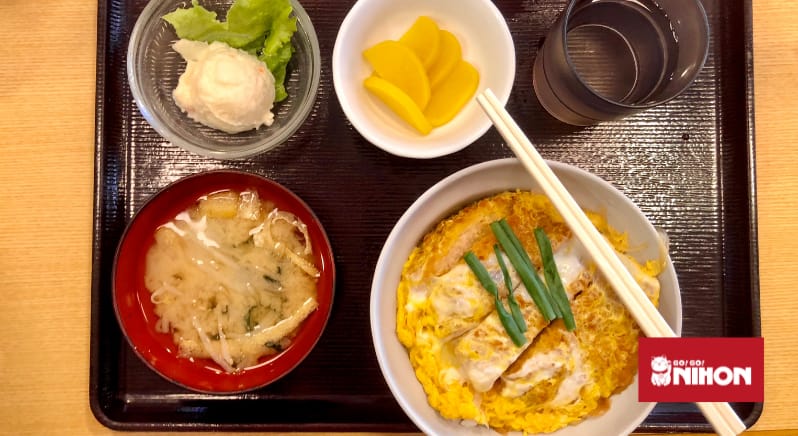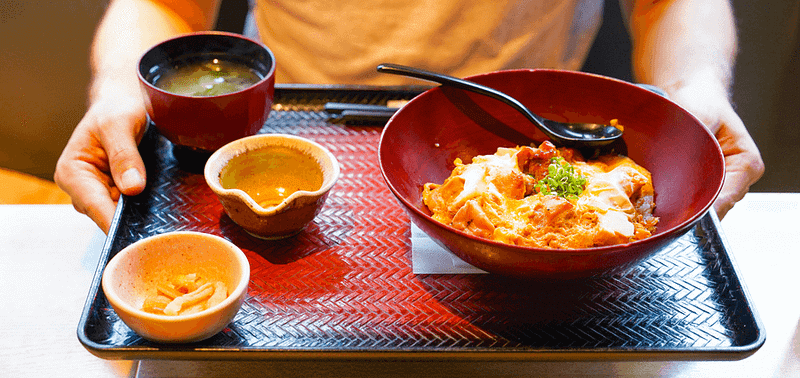Japanese food is delicious! And although eating out in Japan is quite affordable, as a student or someone not residing in Japan it can be a good idea to learn to make Japanese food yourself. We have gathered 5 easy Japanese recipes for you to make at home.
Firstly, in Japanese cooking the rice is very (I mean very!) important. You need to use Japanese short grain rice, sometimes just referred to as “sushi rice”. Japanese rice can not be substituted with long grain rice, so be sure to get short grain rice. Cook it according to the instructions on the package.
These simple recipes will get you started with cooking authentic Japanese food. Our easy Japanese recipes make one serving, so it will be easy to multiply if cooking for more than one person as well.

Omurice
Omurice (オムライス, omuraisu) is short for omelette rice and is just that, an omelette filled with fried rice. It’s a Japanese dish typically made at home, but it’s also a common dish at Japanese family restaurants. There are many different variations and recipes for this Japanese dish, with different ingredients included in the fried rice, flavourings and topping sauces. Here’s our simple, easy and vegetarian take on a classic omurice.
Ingredients
- 1 cup cooked Japanese rice
- 1/4 onion, chopped
- 1/2 carrot, chopped
- 4 mushrooms, chopped
- 2-3 tbsp green peas (defrosted if frozen)
- 3 tbsp ketchup (or gluten-free ketchup)
- 1 large egg
- 1 tbsp milk
- vegetable oil (for frying)
- 1 tbsp butter or margarine (for frying the omelette)
- salt
- pepper
Preparations
Cook the rice according to the package. Chop all ingredients (onion, carrot, mushrooms) and sauté the onions in some vegetable oil. Add the green peas and mushrooms and continue sautéing. Season with salt and pepper, add the cooked rice and break it apart to mix it with the vegetables. Season the mix with the ketchup and stir to combine.
For the omelette crack the egg and whisk it with the milk. Season with salt and add the butter to a pan. Cook the beaten egg on low to medium heat, not letting it brown or cook too fast.
To combine add the ketchup and rice mixture on top of the omelette, horizontally in the middle (with uncovered omelette on both sides of the mixture). Wrap the ketchup rice with the omelette and flip it onto a plate. Decorate with ketchup, to taste, and serve!

Easy Japanese curry
Japanese curry (カレー) is a very popular dish in Japan, warm and spicy comfort food at its best. Our Go! Go! Nihon staff loves curry, both eating out and making at home.
Curry is usually served with rice (カレーライス, karē-raisu), udon noodles (カレーうどん, karē-udon) or as a filling in bread (カレーパン, karē-pan). It’s one of the easiest Japanese recipes to make at home, since you usually use Japanese curry roux cubes to get the characteristic flavour. You can add whatever you like to the curry roux which makes it easy to vary the ingredient to your taste or dietary preference. Japanese curry is also easy to make in big batches, to eat for many days or store in the freezer.
If you want to make a vegetarian curry, make sure to get roux cubes that do not contain meat extract.
Ingredients
- 1 small carrot
- ½ small onion
- 1-2 medium potatoes
- 100g of boneless meat (chicken, pork or beef) or 4-5 mushrooms
- 1-2 cubes Japanese curry roux (¼ of a “big” cube)
- about 200 ml water (the water amount depends on your curry roux- look at the package)
- vegetable oil
Preparations
Peel and dice the carrot, onion and potatoes into similar size pieces. Cut the meat or mushrooms into bite size pieces, similar to the vegetables. Heat the oil in a pan or pot and sauté the onions. Add the meat (or mushrooms) and cook until it browns. Add the carrots, potatoes, and water and bring to a boil.
Remove any foam and simmer on low heat for 15 minutes, until the vegetables are soft and tender. Turn off the heat and add the curry roux and mix. When blended, turn on the heat and simmer for 10 more minutes until the curry thickens. Serve with rice, or noodles. Enjoy!

Shougayaki (Japanese ginger pork)
Ginger pork (生姜焼き, shouga-yaki) is a staple dish in Japanese home cooking and often served at Japanese diners (食堂, shokudou). It’s a very simple but delicious dish full of Japanese flavours. You can make its gluten-free variation using a gluten-free soy sauce.
Ingredients
- 100-150 grams of thinly sliced pork loin
- 1 tbsp soy sauce
- ½-1 tbsp freshly grated ginger (about half a thumb sized piece)
- 1 tbsp sake
- 1 tbsp mirin (or sugar)
- salt
- black pepper
- vegetable oil
- shredded cabbage, for serving
Preparations
Mix the seasonings: freshly grated ginger, soy sauce, sake and mirin in a bowl. Season the meat with salt and pepper on both sides and heat some oil in a frying pan. Cook the meat on both sides and flip when it’s golden in colour. The pork will cook pretty quickly if it’s very thin.
Add the sauce mixture to the pan and make sure the meat is coated in sauce, and let it heat up. Serve right away, on a bed of shredded cabbage. Enjoy alongside rice.

Ochazuke
Ochazuke (お茶漬け) literally means submerged in tea, and is a simple Japanese rice dish. You can use tea (genmaicha or sencha preferred), but it’s more common to use a dashi stock, to cover the rice with. Ochazuke can be made with leftover ingredients and rice, making it a very easy recipe.
Common toppings include flakes of salted salmon, umeboshi (pickled plum), tarako or mentaiko (salty seasoned cod roe).
Ingredients
- 1 cup cooked Japanese rice
- 1 cup of dashi stock (instant dashi powder + boiling water)
- ½ tsp soy sauce
- 1 tsp bubu arare (small rice crackers) or 1 crumbled rice cracker (senbei)
- 2 tbsp salted salmon flakes
- 1 tsp roasted sesame seeds
- shredded nori (seaweed)
- 1 shiso leaf, shredded
- wasabi
Preparations
Cook the rice according to the package. Use pre-salted salmon (or prepare 1 day in advance by seasoning 1 salmon filet with 1 tsp sake and 1 tsp salt) and cook in the oven at 400℉ (200℃) for about 25 minutes. When cooked, remove skin and flake the salmon into small pieces. You can also buy pre-made salmon soboro (salmon flakes).
Use instant dashi powder or make your own dashi stock, and add the soy sauce.
Assemble by putting the cooked rice in a bowl, add the salted salmon flakes, shredded nori, sesame seeds, rice crackers and shiso leaf. Gently pour over the hot dashi mixture and enjoy. Wasabi can be added for an extra punch.

Tonkatsu
Tonkatsu is a Japanese breaded and deep fried pork-cutlet usually served with shredded cabbage and tonkatsu sauce. It is also often served as a rice bowl (かつ丼, katsudon) or as filling in a sandwich (かつサンド, katsu-sando).
Tonkatsu sauce can be made from scratch but for this recipe we use store bought tonkatsu sauce (sometimes called bulldog sauce, because of the famous bulldog sauce brand).
Ingredients
- 1 slice of pork loin
- 1 egg
- all purpose flour
- panko bread crumbs
- salt
- pepper
- vegetable oil
- tonkatsu sauce
- 1 lemon wedge
- shredded cabbage, for serving
Preparations
Slice the sinews (connecting tissue) between the fat and flesh, to prevent the pork loin from curling up when cooked. Pound the meat with a meat pounder or the back of a knife to soften. Season with salt and pepper on both sides.
Beat the egg in a bowl and add flour and panko into 2 other, separate, bowls. Coat the pork loin with flour, shaking off any excess. Dip the floured pork in the beaten egg and then in the panko bread crumbs. Shake off any excess.
Heat the oil to 340℉ (180℃). Or, if you don’t have a cooking thermometer, use a chopstick to check the oil. Stick the chopstick in the oil; you know it’s ready when you see small bubbles around the tip of the chopstick. It’s important that the oil isn’t too hot, otherwise the outside will burn before the pork inside is cooked through!
Gently place the breaded pork in the oil to cook. When the surface becomes crisp and golden brown, after 1-3 minutes, flip it carefully to cook the other side. When both sides looks golden, take out the cutlet and drain well on a wire rack or paper. Leave to rest for 4-5 minutes before cutting the tonkatsu into 3-5 large pieces and serve with shredded cabbage, lemon wedge and some tonkatsu sauce.

Easy bonus recipe: Onigiri
Maybe the number one ‘easy Japanese recipes’ is onigiri, Japanese rice ball. Sure, onigiri is quite cheap and easy to get at a konbini but it’s even cheaper to make at home. And you can fill it with whatever you like, season it with rice seasonings or even have it plain. You can make a vegetarian variation, using umeboshi (梅干し, pickled plum) or any other type of vegetable.
Ingredients (makes 2 onigiri)
- 1 cup cooked Japanese rice
- 1 nori (seaweed) sheet
- 2 tsp Japanese mayonnaise
- 1 tbsp canned tuna
- salt
Preparations
Cook the rice according to the package (you need about ½ cup cooked rice per onigiri). For the plain onigiri: simply wet your hands in water, sprinkle some salt on your palms and rub them together to distribute evenly. Take a small handful of rice in your hands and form a triangle. Use ⅓ of a nori sheet to wrap around the rice ball. Done!
To make onigiri filled with tuna mayo, also called sea chicken (シーチキン, shīchiken), mix the canned tuna with the mayonnaise. Water and salt your hands again and take a handful of rice in your hands. Make a small well (dent) in the middle of the rice and add your tuna mayo filling. Press the rice gently around the filling to form a triangle. Wrap ⅓ of a nori sheet around the onigiri. Done!
Japan is renowned for its refined and tasty food. Master the skills behind cooking Japanese food through classes on airKitchen. We hope you will try these easy Japanese recipes and start cooking Japanese food at home!
If you like to read more about Japanese culture, make sure to follow our blog where we cover everything you need to know about Japan!


















